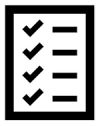Learning Objectives
By the end of this module, you should be able to:
- Learn how to evaluate and summarize feedback from your Getting out of the Building
- Understand the difference between pivoting and iterating
- Evaluating how you should pivot or iterate with your startup idea
The “Getting out of the Building” process can be overwhelming, and it presents the entrepreneur with a lot of potentially conflicting evidence. If the evidence and the feedback challenges your ideas of whether you have product-market fit, then this could be a good thing! This means that you are looking at your startup critically, and listening to what the customers are telling you. It is very rare to find product-market fit on the first try – very rare. This means that you have to use your problem-solving skills in order to make changes until you do. This can take several rounds of customer feedback, but remember, it is all about making changes to an MVP and to your BMC. Imagine if you had borrowed and invested $1M to make an initial product when you only needed $1000 for an MVP. How would you feel in the case of the $1M investment? What about the $1000 investment? In which situation do you feel you would most likely and able to change course?
Making sense of the feedback you receive starts with re-examining what the customer has told you. To give us a better idea on how to do this we will return to Steve Blank’s blog, back to his page containing slides and videos (https://steveblank.com/slides/).
After watching these videos, have another close look at your interviews. Make some notes after each one to summarize some of the key things that you have learned. Are there any outliers, and what types of interesting things did they have to say?
At this point, make a few notes (either mental or on paper) that summarize the findings from your interviews. Your notes should essentially answer questions that include “what were my main assumptions before the interviews? “what was wrong about these assumptions?” and “what do I change going forward?” What you decide to change can be described as a pivot or iteration.
In simple terms, the difference between a pivot and an iteration is a question of magnitude: an iteration is a smaller change to your MVP or business model, and a pivot is a larger change to your underlying business model. In both situations, it is generally understood that the mission or the overall problem that the business is trying to solve remains largely unchanged. We will let Eric Ries and Steve Blank expand on this explanation:
Steve Blank further explains the difference between a pivot and an iteration:
Now that you know the difference between pivoting an iterating, there should be two main questions on your mind: “How do I pivot in my business idea?” and “how many times should I pivot or iterate before I proceed with my idea?” Unfortunately, the answers to these questions are not straightforward. The first question suggests that you should really consider what your customers are saying. If there doesn’t really seems to be a product-market fit, then your pivots should probably start within your value proposition. There are several broad places to start, as the article below from Strategyzer outlines. Consider if one of these six ways is useful for your value proposition canvas, and what that might look like as an MVP. Would it solve the needs of the customers that you spoke with?
If you found that you really do have product-market fit, then congratulations! Perhaps your innovations or pivots can come from elsewhere in the business model canvas. Each segment of the business model canvas has potential for innovation, it is just a matter of asking the right questions. For the first example, let’s look at revenue streams, and the impact of changing the revenue streams. If we are a company producing local Newfoundland honey, the traditional way to earn revenue is a straight asset sale – money for honey! What if we offered a subscription honey service, making the revue stream a subscription for a monthly honey kit? This completely changes the business model!

Another example of business model innovation comes from the micro-brewery industry. Here we can show examples of innovation on key resources and key partnerships. Traditionally breweries have their own brewing equipment. During slow times, this equipment sits idle. This gave rise to “gypsy” brewers. These brewers use the equipment of other breweries to brew their own batches. The brewery gets a fee when their equipment is idle, and the gypsy brewer gets equipment to brew a batch of beer, and do not need these resources. Interestingly, we have no brewers of this kind in Newfoundland yet. Have a look at the changes that are possible in your business model.
The final question is about how many rounds of interviews are needed before moving on. Again, this is not straightforward. It mostly depends on if you really think you’ve achieved product-market fit. Steve Blank explains this below:
This is where you must decide – pivot or proceed? If you need to pivot, look at some of the guidelines in this module. If you made large pivot, you may have to go back and try to validate your new value proposition, your BMC, and your new MVP. If you need to refresh your understanding of this, go back to the start of Section 2 of this course. Remember, this is not a failure. It is not likely that you have a perfect business model at this point, and pivoting is evidence that you learned!

- Summarize the findings from your Getting out of the Building interview rounds using the questions in this module. Do you still feel that you have product-market fit?
- If you answered ‘no’ above, how can you pivot? Do you need to start with the value proposition? Make the changes necessary to your MVP, VP and BMC. This may require some conversations with mentors or the Navigate program manager. Feel free to contact them for help at this point.
This section of the course brought you through the core of the LEAN startup method – Build, measure, learn. Before moving onto the next section of the course, make sure that you have enough feedback to have a validated business model. This would have included several iterations of your BMC, value proposition, and MVP. The next section has a look at some resources for you to get started on finding funding for your startup!

